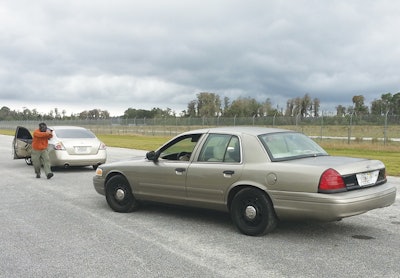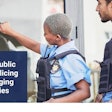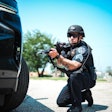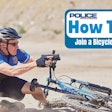 Photo: Amaury Murgado
Photo: Amaury Murgado
Of the 530 officers killed between 1998 and 2008, 106 were killed in an ambush, according to the FBI's Law Enforcement Officers Killed and Assaulted report. That's a significant number and equates to 20% of all officers feloniously killed. This is why you owe it to yourself to seek training that will help you avoid such a fate, including how to handle an ambush in your vehicle. A recent incident helps illustrate a classic example of a vehicle ambush where a handgun was involved.
On the morning of Feb. 28, 2013, 35-year-old Sgt. Gary Morales, a 13-year veteran of the Saint Lucie County (Fla.) Sheriff's Office, conducted a traffic stop. At some point during the stop the suspect, 25-year-old Eriese Tisdale, got out of the driver's side of his car and ran over to where Sgt. Morales was sitting in his patrol car. Tisdale extended his arm and opened fire. He then stepped back away from the patrol car and fired again. In a matter of seconds, Morales had been hit multiple times. One of the rounds severed the main artery in his neck, which contributed heavily to his death.
Sgt. Morales's death was a tremendous loss for his family, his agency, and law enforcement as a whole. Unfortunately, incidents like this are happening far too frequently and becoming commonplace. When faced with this reality, the question becomes, "What can we do to help mitigate such attacks?" The obvious answer is to create a training program that helps to curtail our losses.
My agency, the Osceola County (Fla.) Sheriff's Office, recently presented an in-service training program that was developed and presented by Dep. Rich Doty from our Training Unit. He tackled the issue by focusing on the only three possible options available when attacked in your vehicle: retreat, run the suspect over, or get out and fight.
Pre-Ambush Considerations
Before getting into the three options, let's briefly cover what you should be thinking of before you ever stop to park your car. "Situational awareness" is one of those phrases officers hear in training but seldom put into practice. Don't make that mistake, or it could be your last. You always need to know what's going on around you.
You need to be in the moment and focusing on the task at hand when responding to a call, not just trying to solve the crime via your in-car computer. That means getting as much information as you can, calling in your position on the radio, and looking at your approach from a tactical and strategic perspective as you decide where to park.
Your approach is critical if for no other reason than it helps set up your escape. For example, park too close and you won't be able to drive forward. Get blocked in by traffic and you won't be able to drive backward. Use what's around you to your advantage and to the disadvantage of the suspect. Everything you do must have a purpose. It doesn't matter whether it's during a field interview, obtaining control of a resisting suspect, or driving; your goal is to screw up the suspect's initiative by taking away as many of his or her options as possible.
Another consideration is making room in your vehicle so you can crouch down in the seat. Every police vehicle shares the same obstacles; it is loaded with kit and very confining. Crouching down in the seat is easier said than done, so you need to make adjustments and practice it. If you're a Field Training Officer, you need to practice this from the passenger side. Also, if you have never practiced drawing your gun from inside your vehicle, on both the driver and passenger side, you have already given the suspect a huge advantage over you.
Retreat
As you drive up to a call, you look for an acceptable place to park. You find a place, stop, place your car in park, and start to unbuckle your seat belt before you turn the car off. Unbeknownst to you, you have driven into a kill zone and find yourself in an ambush. You start taking rounds and your world is reduced to yelling, loud bangs, and exploding glass. Now what?
During a retreat, the idea is to crouch down or lie down on the seat so you can use as much of the engine block as possible for cover. You then drive backwards and create distance between you and the kill zone. If you were paying attention to your surroundings during your approach, you should be able to use your view of telephone wires, rooftops, light poles, etc., to help you orient yourself from your crouched or prone vantage point.
Your goal is to get away from the kill zone and get into a position that will allow you to exit your vehicle and counter the attack. Try to position your vehicle between yourself and the suspect so you are using as much of the engine block as possible. You should know by now that the doors of your cruiser themselves provide little to no protection.
Get on the radio as soon as you can and call for backup. If there is enough of a lull, try to get to your shotgun or rifle and assess if you need to move to a more tactical location. Trust me, all of this sounds a lot easier than it is and you need to practice this tactic.
Run Over the Suspect
Driving over a suspect with your vehicle is probably the most controversial tactic police officers can use, and I take no issue with it. For example, if someone jumps out of his car shooting at you during your traffic stop, you don't have time for much of anything. He is not shooting at you to get your attention; he is trying to kill you.
In a life-and-death situation there are two kinds of people: those who survive and those who don't. If you are justified in using deadly force, the action you take to defend your life is warranted. In this respect, there is no difference between shooting someone and running him over.
For another example, say you start to park your car when all of a sudden someone comes around the corner of a building and starts shooting at you. She is running toward you and rounds are hitting your car. You can't retreat because you are too near a curve with heavy traffic. You decide that running the suspect over to stop the threat is your only viable option.
Crouch down in the seat, put the car in drive, and punch it toward the shooter. Whether you hit her or not, keep driving out of the kill zone. And as before, position your car in a way that lets you get out and prepare for your counter attack. As before, remember to place your car in such a way to take full advantage of the engine block for cover.
If you do hit the shooter, be prepared for the possibility that you might have only slowed her down and she could still attack you. Be prepared to engage the suspect if you still have to. As in all ambushes, always be prepared for multiple assailants, hence the need to get out of the kill zone, gain a tactical advantage through distance, and prepare to continue to fight off other attackers.
Get Out and Fight
The third option is to neither go forward nor backward but to fight outside of your vehicle. You are ambushed and the suspect is coming toward you while firing his handgun. What do you do?
In my agency's recent training I did what I had always done before; unlock the doors, get out, take a shot or two at the suspect, and then get some distance between us and continue the fight. Adding Airsoft pistols, however, showed me that I would be hit several times before I could get into any tactical position doing what I was doing. Just trying to draw my gun as I was exiting the vehicle was not as simple as one would think. It's a good thing I attended the training.
At one point, Dep. Doty asked me why I wasn't firing through the window first and then trying to get out of the car. I really didn't have an answer for him other than under stress you do what you've always trained to do. As much as I preach using the OODA Loop, that day I had to change mine in order to effectively change that of the suspect. A better approach is to fire out your front windshield and then try to get out once you've redirected the suspect's attention.
The Real Deal
When you train in realistic scenarios, you get a feel for what might actually happen to you. During my training day, I fared better than most since I do practice drawing my gun from within my patrol car. But I also banged my head twice getting out of the car and almost tore off a fingernail that caught on who knows what.
Getting ambushed is something we must all be prepared to deal with. Focusing on the three options of retreat, run the suspect over, or get out and fight will go a long way toward preparing yourself for someone firing on you in your vehicle.
Amaury Murgado is a special operations lieutenant with the Osceola County (Fla.) Sheriff's Office. He is a retired master sergeant from the Army Reserve, has more than 25 years of law enforcement experience, and has been a lifelong student of martial arts.


















